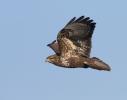

The Buzzard is not an endangered species. The Buzzards is protected by the Wildlife and Countryside Act of 1981. Animals like foxes and wild cats could potentially hunt healthy adults, and Golden Eagles would have no problem dispatching these smaller raptors. However, injured and sick individuals may fall prey to various carnivores. Healthy adult Buzzards have few predators. The Buzzard can live for at least 28 years, although their average life expectancy is much lower at about eight years. Keep reading to learn about their threats and conservation status. The Buzzard has made a remarkable comeback in the United Kingdom, with numbers rebounding from a low of just 1000 breeding pairs in the early 20th century. The young will be fed periodically for up to two months after leaving the nest. The male provides food for the first two weeks, but the female brings most food after the first month.

What do Buzzard chicks eat?īoth male and female Buzzards feed their chicks strips of meat and other manageable morsels. Beetles, earthworms and other invertebratesĬheck out our complete guide on the diet and feeding behaviour of a Buzzard.Birds like pigeons and starlings, and up to the size of partridges and pheasants.The Buzzard is known to eat the following animals: Voles and other rodents are their major prey source, but they will eat a variety of animals, including invertebrates and carrion when available. What do Buzzards eat?īuzzards are purely carnivorous, although they are not fussy about choosing their prey. Continue reading to learn more about their diet in the UK. The Buzzard is an opportunistic hunter that eats a variety of prey animals.


 0 kommentar(er)
0 kommentar(er)
